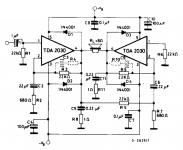I am contemplating building a cheap low-power gainclone and am going for bridged TDA2030s so I can run it off a laptop power brick. Attached is the split-supply bridged schematic from ST's datasheet.
I will generate a virtual ground using TLE2496 or similar. The question is about the zobel of each amplifier's output. Can I safely assume that the amount of current flowing into the virtual ground at any time will be negligible - less than 20mA? Also, is it possible to connect a zobel directly between the two outputs instead of between output and ground?
Second question: Which arrangement for power capacitor is better in this case? (see second attachment)
I will generate a virtual ground using TLE2496 or similar. The question is about the zobel of each amplifier's output. Can I safely assume that the amount of current flowing into the virtual ground at any time will be negligible - less than 20mA? Also, is it possible to connect a zobel directly between the two outputs instead of between output and ground?
Second question: Which arrangement for power capacitor is better in this case? (see second attachment)
Attachments
Last edited:
Quick question - with a bridged amp, why use a virtual ground. Should be able to build it without (but Zobels would still go to ground) ...just wondering...
To bias the + input at the midpoint between V+ and 0V.
To bias the + input at the midpoint between V+ and 0V.
I am in the keep it simple camp - two resistor voltage divider - or 3 and a large cap to decouple power supply (input resistance parallel of two resistors after cap). Nothing wrong with doing it your way. Good luck.
I think it is better idea to use the virtual ground instead of resistor voltage divider. If you use a simple resistor voltage divider, the behavior of amplifier won't be good when the supply voltage will fluctuate in power peaks. The first reason is the slow reactions of resistor voltage divider and second reason is half of supply voltage on the capacitor, which is grounding feedback resistor divider - the voltage on this capacitor can't fluctuate such fast and it will cause non-symmetric limitation on quite low output power after every power peak.
If you use the virtual ground for grounding of this capacitor and also for biasing the input of TDA, the behavior will be much better. So don't keep it so much simple.
If you use the virtual ground for grounding of this capacitor and also for biasing the input of TDA, the behavior will be much better. So don't keep it so much simple.
actualy i kindof don't get why would the OP want this amp in the first place..
it seems to be quite a bit more complex then an amp needs to be.
no to mention that tda 2030 is not a chip known for its fidelity.(not that it sounds bad or something, but there are similar chips with better specs and not realy that higher priced)
might first investicate what was the base idea for this amp,
what load will it drive (rated impedance, sensitivity, power requirements)
why was this amp choosen?
what voltage can the laptop brick provide?
Actualy i would only try this if.. i was experimenting with the design.
I kindof think that -in case information is provided- maybe a simpler solution could be utilised, but it may be just my big mouth again even so this post was written with the verry best intention.
even so this post was written with the verry best intention.
it seems to be quite a bit more complex then an amp needs to be.
no to mention that tda 2030 is not a chip known for its fidelity.(not that it sounds bad or something, but there are similar chips with better specs and not realy that higher priced)
might first investicate what was the base idea for this amp,
what load will it drive (rated impedance, sensitivity, power requirements)
why was this amp choosen?
what voltage can the laptop brick provide?
Actualy i would only try this if.. i was experimenting with the design.
I kindof think that -in case information is provided- maybe a simpler solution could be utilised, but it may be just my big mouth again
- Status
- This old topic is closed. If you want to reopen this topic, contact a moderator using the "Report Post" button.
- Home
- Amplifiers
- Chip Amps
- Questions on bridged, single supply TDA2030

